How to Make Homemade Fresh Lilac Cordial with Lemons Recipe
Five years ago, I made my first-ever Lilac Cordial. I read about the recipe in an old Victorian cookbook ( a wildly fun find at a flea market). At that time, we had just relocated our family back to the foothills of California to be close to the trees, soil, and bedrock I knew in childhood. We arrived ragged and in so much need of replenishment. In need of rest. In need of learning to love each other again.
That spring, I discovered three large unruly lilac shrubs growing in our yard. They burst into purple fireworks of heavenly-scented blossoms at the start of April. Learning that lilac blossoms are edible flowers from the antique recipe, I gathered 20 heads of the lilac blooms and brought them back into my kitchen. I removed the flowers from their stems and stuffed them into the largest sterilized glass jar. I cut up three Meyer lemons and added them to the jar. On the stove, I brought 16 cups of water to a boil, added 8 cups of sugar, and stirred well until, like magic, the sugar dissolved and disappeared into the water.
Carefully, I poured the simple boiling syrup over the sliced lemons and lilac flowers and filled the jar. I left a pinky finger’s worth of space at the top of the jar. I tightened the lid on the jar and allowed it to sit for four weeks on my counter, away from direct sunlight. After weeks of waiting, we popped the lid off the jar and witnessed the most amazing scent of lilacs and lemons mingling with the daintiest bubbles of a light ferment.
We strained the cordial, poured 1/8th cup into a glass, and added 2/3 cup of fizzing seltzer water. It was like drinking the sweet rejuvenating nectar of spring. Ever since we have made lilac cordial at the start of spring. If you have lilacs blooming, I encourage you to try this old process of preserving the aroma of spring that you can enjoy all through the summer and autumn months.

Lilac Blossom Cordial Recipe (Based on the Antique Victorian Recipe)
As an Amazon Associate, I earn from qualifying purchases.
Ingredients:
- 20 heads of fresh lilac blossoms, gently washed and dried
- 3 Meyer Lemons, sliced
- 8 cups of white sugar
- 16 cups of cold water
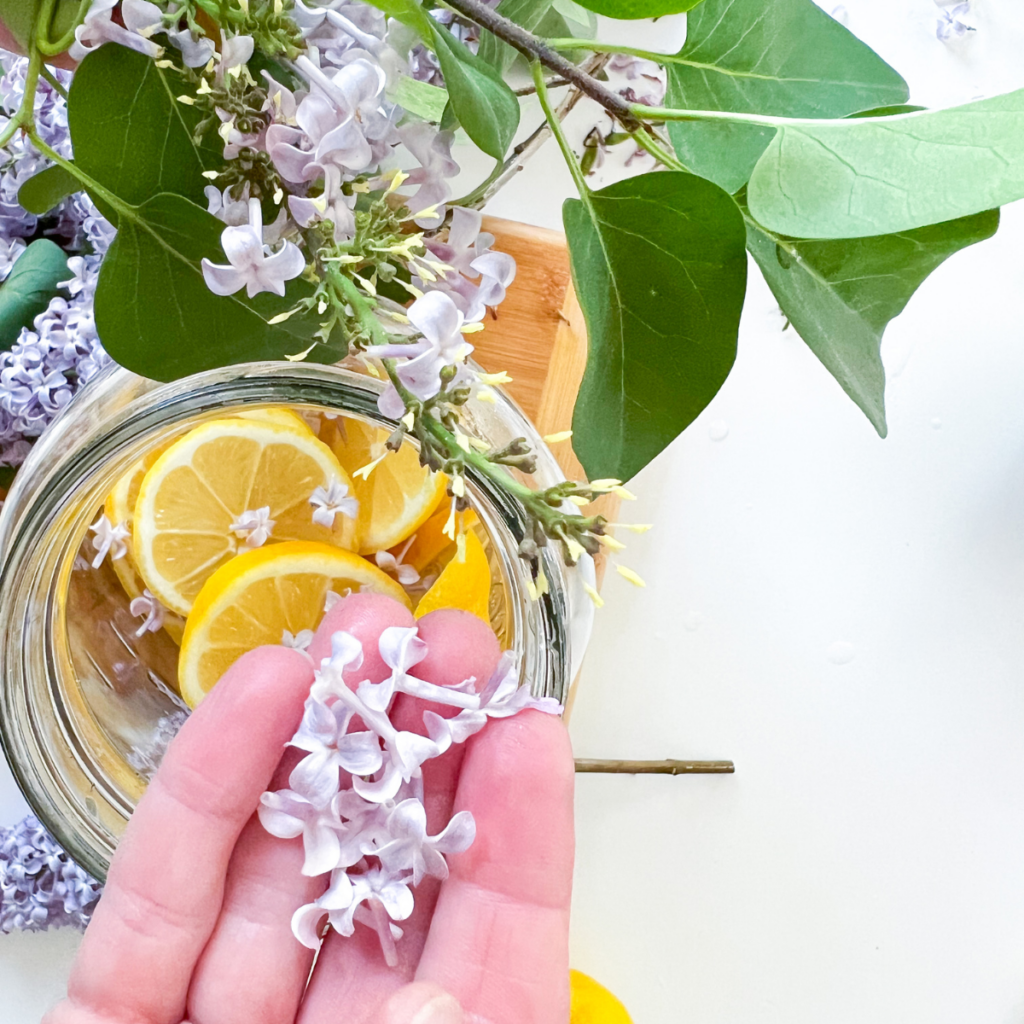
For the last five years, I have made a version of this cordial as a lilac syrup. It’s similar to a cordial, except no sitting time is needed. If you’re in a hurry to enjoy the flavor of the lilac season, try making lilac tea, lilac sugar, or lilac-infused honey. If you’ve missed lilac season, don’t despair! Elderflowers work just as well to make an elderflower cordial version.
If you don’t wish to use white table sugar, any organic low-processed sugar will work for this recipe. I discourage using honey for this method as it will not react the same during fermentation.
This recipe works best with fresh flowers, as they contain the natural Lactobacillus needed to create the light fermentation.
Supplies:
- Colander
- Measuring Cups (Pyrex Brand)
- Airtight Container for storage (I prefer an extra-large Mason Jar)
- Knife
- Cutting Board
- Sauce Pot with a Lid
- Kitchen Towels
- Small bowl
- Optional: Funnel
Instructions:
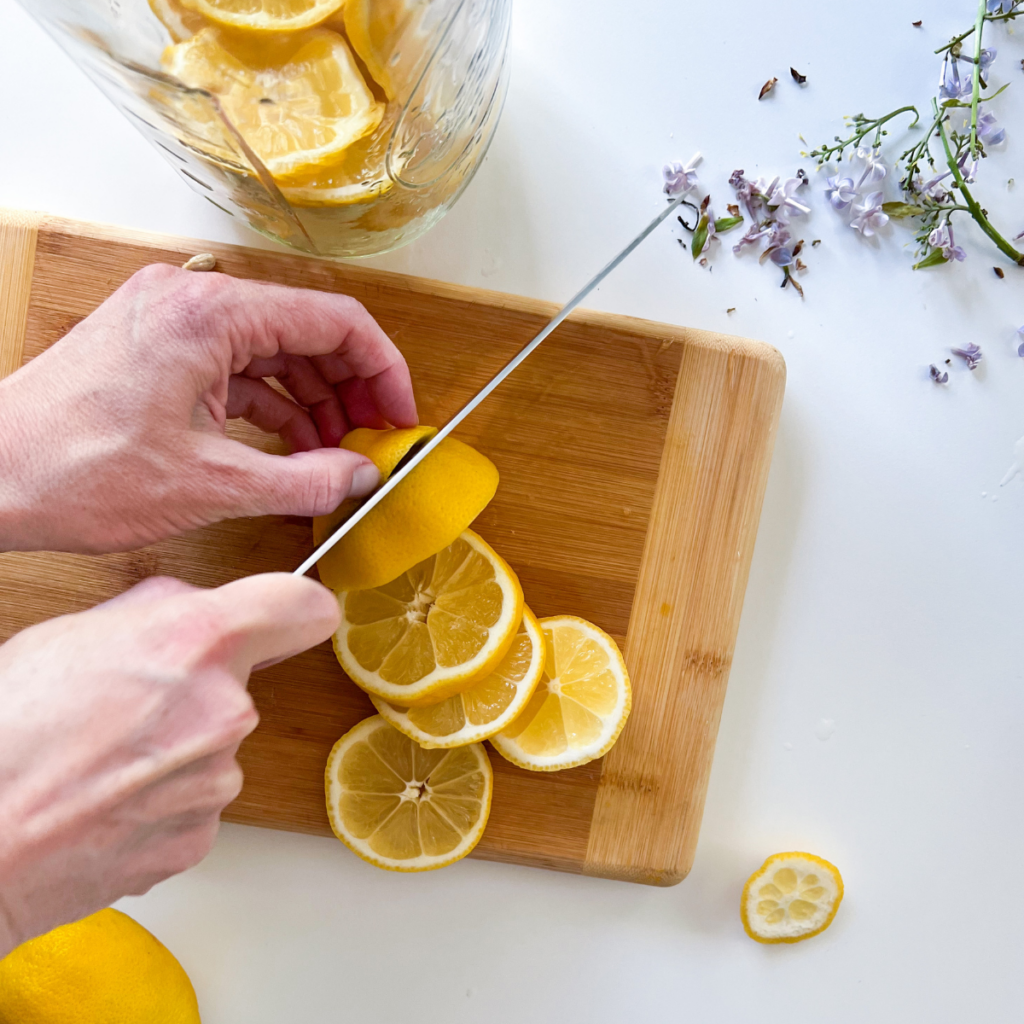
- The first step is to pick 20 fresh heads of individual blossoms from a Lilac bush that you know is not sprayed with pesticide. Pick Lilacs that are in full bloom.
- Wash the flower heads and pat them dry with a clean kitchen towel.
- Once dry, pluck the flowers from the stems and discard the stems and leaves. Remove any green parts from the flowers. Set the fresh blooms aside in a small bowl.
- Using your measuring cups, pour 16 cups of water and 8 cups of sugar into a pot, and bring the contents to a boil.
- Stir the sugar and water until the sugar has dissolved, and remove the pot from the stove’s heat.
- Slice the lemons and place the lemon slices into a sterilized, clean large jar you use for the cordial.
- Pour the trimmed and plucked fresh flower clusters into the jar onto the lemon slices.
- Carefully pour the hot syrup over the flowers and lemon slices. All the jar and its contents sit at room temperature for several hours.
- When the jar is warm to the touch, place the lid onto the jar tightly and allow it to sit in a cool place for at least 3-4 weeks.
- After the cordial has sat undisturbed, gently unscrew the lid and release any air bubble build-up. Your floral syrup will have transformed into an intoxicating scent of spring with a beautiful floral flavor and the lightest touch of bubbles.
- Store your cordial in the same jar in your refrigerator for up to one year. For longer storage, pour the cordial into silicone containers (we like these from Soupercubers) and freeze them as individual serving icecubes.
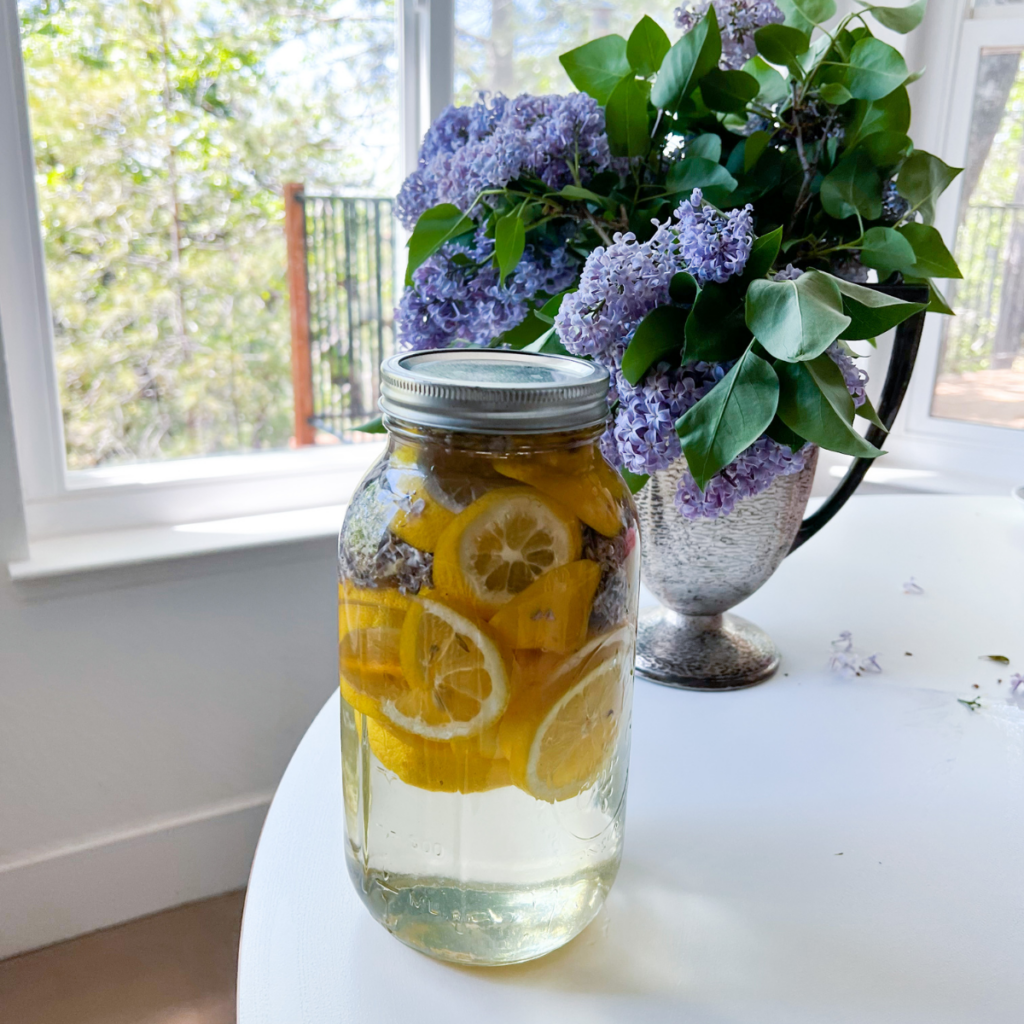
How to Serve Lilac Cordial
Indulge in your new cordial by measuring 1/8th cup of the cordial into an 8 oz glass filled with ice. Pour cold water or seltzer water over the floral syrup and mix lightly. Sip and enjoy!
For even more indulgence, freeze a few fresh lilac blossoms into an ice cube tray and serve the cordial with the floral ice cubes for a touch of whimsy and delight.
Make Lilac lemonade by mixing 1/4 cup of the cordial into any lemonade recipe for an added burst of floral aroma and flavor. Serve your cordial at your next garden party, or tea party, or sip during the summer evenings as a delicious mocktail.
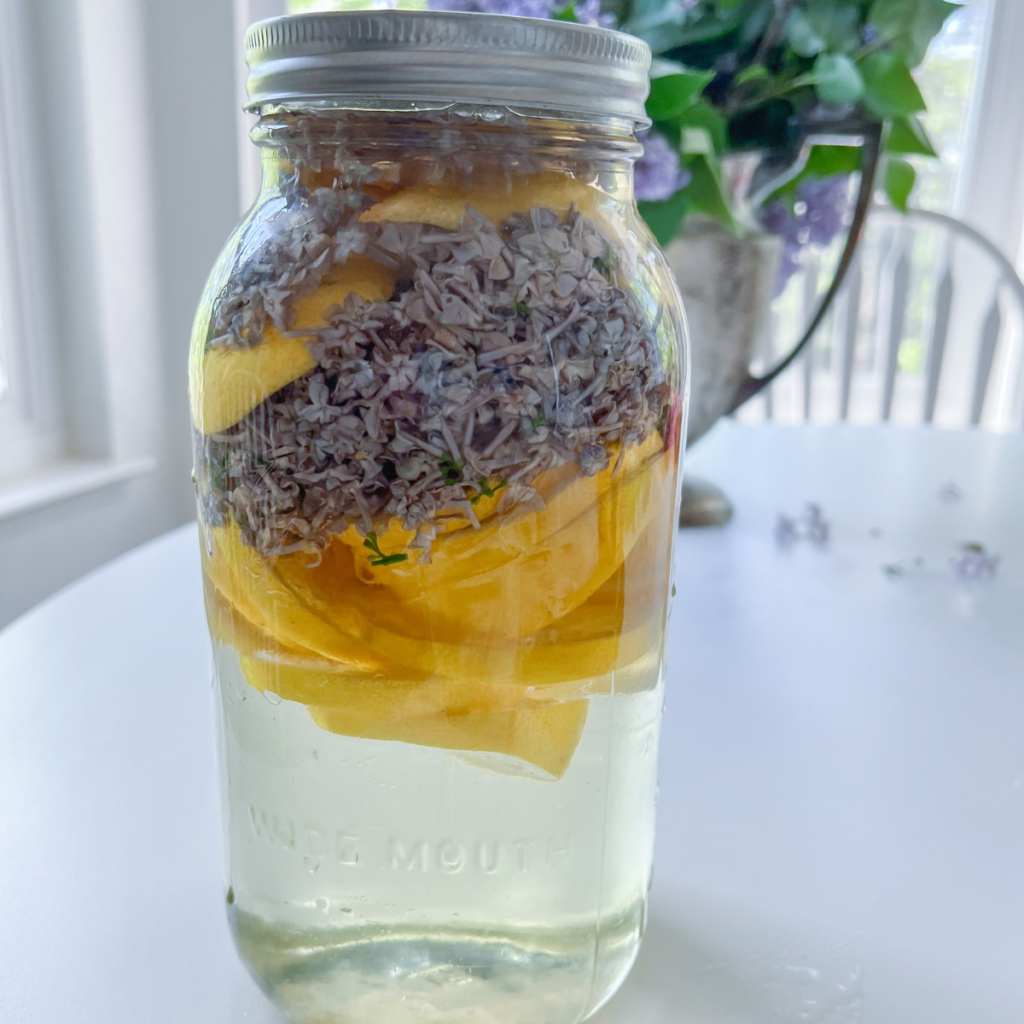
Storage and Shelflife
The lilac cordial should be stored in clean, airtight containers in the refrigerator. Because the cordial contains all-natural ingredients and does not have preservatives, it may spoil quickly if left at room temperature for a long time.
As long as the cordial is stored in the refrigerator, it lasts 12 months. In the freezer, the cordial can last up to 3 years.
If you do not wish to wait 3-4 weeks to enjoy your cordial, you can start partaking in the lilac flavor within 24-38 hours after the lilac blossoms have infused into the simple syrup and lemon juice mixture. You will know the syrup is ready when the flower blossoms have lost their color, and the contents of the jar take on a light purple hue. Pour a splash of the syrup into a cup and enjoy with your favorite light liquor or use it in baking to infuse your baked goods with light flower essence.
Some recipes will suggest adding 1/4 to 1/2 teaspoon of citric acid to the cordial as a natural preservative. This addition may alter the flavor of the cordial to more acidic and there isn’t any need for added preservation as long as the cordial is stored in the refrigerator.
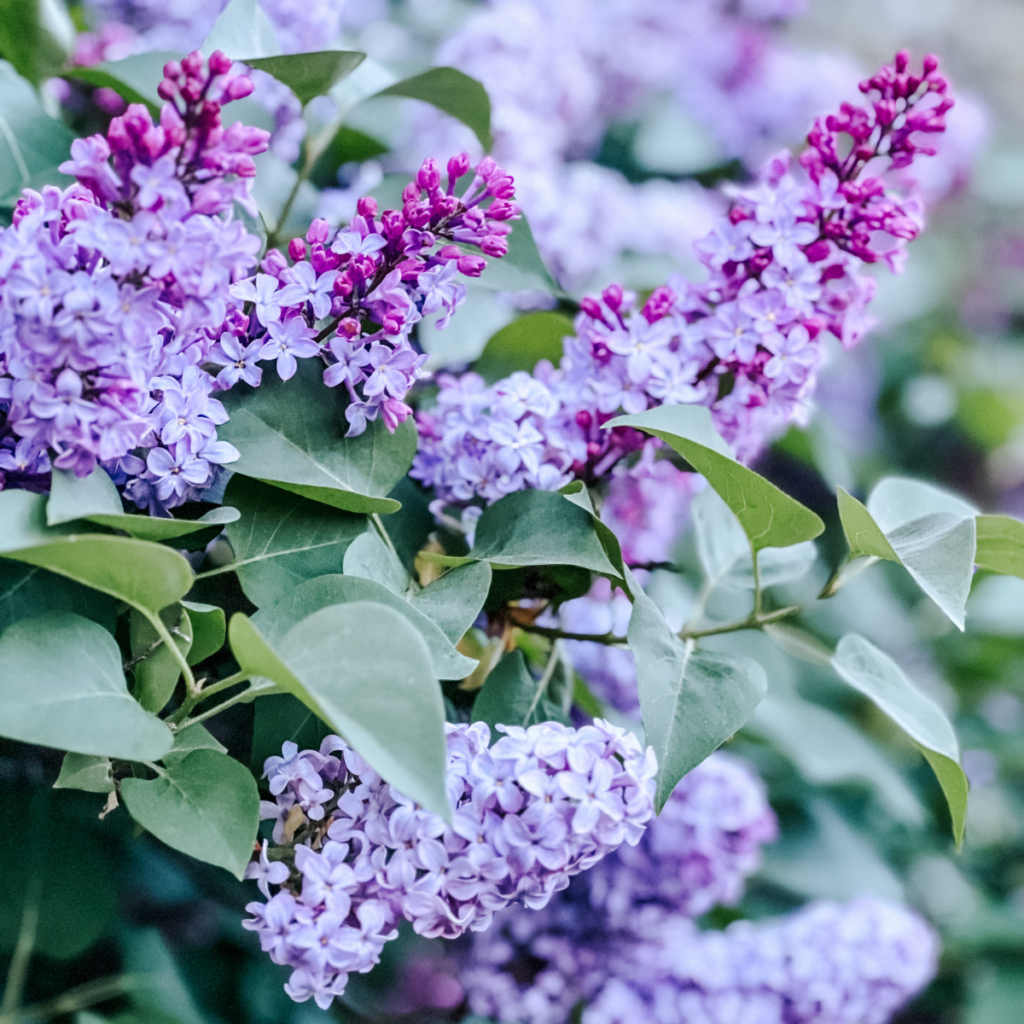
Benefits of Lilacs
Herbalists and individuals have used lilacs to tend to sore mouths and as a natural dewormer. Its tea has long been used to treat high fevers and rashes. Lilac-infused teas and water enhance relaxation and benefit anyone facing anxiety.
This recipe, based on an antique Victorian method, uses fresh lilacs for their exquisite scent and aroma. The scent has been long celebrated for its potency to ward off distasteful smells and as a sensory way to welcome spring and almost the start of summer.
Which Variety of Lilacs Can Be Used in Cordial?
The good news is that all varieties of lilac flowers are edible. From Sensation varieties to President Grevy lilacs, you can use any variety of fresh lilac blossoms from any lilac bushes to make your lilac cordial. View all of the varieties of lilac flowers on this easy to scroll through carosel. The key to making delicious lilac cordial is to ensure you are using fresh lilac flowers.
FAQs about Lilac Cordial
This recipe makes 16 ounces of lilac cordial.
Add the cordial to fresh cold water for a refreshing drink, or pour bubbly seltzer water over the cordial for a refreshing fizzy drink. The cordial is also tastily mixed with white wine, lemonade, and gin.
Making recipes based on antique and old methods connects us to the positive attributes of the past and brings them forward into our modern world. Plus, it’s just so fun! Cordials are a wonderful way to start exploring the world of foraging and making with fresh flowers.
Looking for other ways to preserve spring blooms?
EASY INFUSED LILAC FLOWER HONEY RECIPE FOR SPRING
HOW TO MAKE HANDMADE GLYCERINE SOAP WITH DRIED MARIGOLDS & GEMSTONES
HOW TO USE CALENDULA FLOWERS TO DYE FABRIC (DIY NATURAL DYE)
Pin it for later!

EASY LILAC CORDIAL

Make easy and delightful lilac cordial with fresh lilac blooms. A wonderful way to preserve the aroma of springtime.
Ingredients
- 20 heads of fresh lilac blossoms, gently washed and dried
- 3 Meyer Lemons, sliced
- 8 cups of white sugar
- 16 cups of cold water
Instructions
- The first step is to pick 20 fresh heads of individual blossoms from a Lilac bush that you know is not sprayed with pesticide. Pick Lilacs that are in full bloom.
- Wash the flower heads and pat them dry with a clean kitchen towel.
- Once dry, pluck the flowers from the stems and discard the stems and leaves. Remove any green parts from the flowers. Set the fresh blooms aside in a small bowl.
- Pour 8 cups of water and 8 cups of sugar into a pot, and bring the contents to a boil.
- Stir the sugar and water until the sugar has dissolved, and remove the pot from the stove's heat.
- Slice the lemons and place the lemon slices into a sterilized, clean large jar you use for the cordial.
- Pour the trimmed and plucked fresh flower clusters into the jar onto the lemon slices.
- Carefully pour the hot syrup over the flowers and lemon slices. All the jar and its contents sit at room temperature for several hours.
- When the jar is warm to the touch, place the lid onto the jar tightly and allow it to sit in a cool place for at least 3-4 weeks.
- After the cordial has sat undisturbed, gently unscrew the lid and release any air bubble build-up. Your floral syrup will have transformed into an intoxicating scent of spring with a beautiful floral flavor and the lightest touch of bubbles.
- Store your cordial in the same jar in your refrigerator for up to one year. For longer storage, pour the cordial into silicone containers (we like these from Soupercubers) and freeze them as individual serving icecubes.
Notes
How to Serve Lilac Cordial
Indulge in your new cordial by measuring 1/8th cup of the cordial into an 8 oz glass filled with ice. Pour cold water or seltzer water over the floral syrup and mix lightly. Sip and enjoy!
For even more indulgence, freeze a few fresh lilac blossoms into an ice cube tray and serve the cordial with the floral ice cubes for a touch of whimsy and delight.
Make Lilac lemonade by mixing 1/4 cup of the cordial into any lemonade recipe for an added burst of floral aroma and flavor. Serve your cordial at your next garden party, or tea party, or sip during the summer evenings as a delicious mocktail.
Storage and Shelflife
The lilac cordial should be stored in clean, airtight containers in the refrigerator. Because the cordial contains all-natural ingredients and does not have preservatives, it may spoil quickly if left at room temperature for a long time.
As long as the cordial is stored in the refrigerator, it lasts 12 months. In the freezer, the cordial can last up to 3 years.
If you do not wish to wait 3-4 weeks to enjoy your cordial, you can start partaking in the lilac flavor within 24-38 hours after the lilac blossoms have infused into the simple syrup and lemon juice mixture. You will know the syrup is ready when the flower blossoms have lost their color, and the contents of the jar take on a light purple hue. Pour a splash of the syrup into a cup and enjoy with your favorite light liquor or use it in baking to infuse your baked goods with light flower essence.
Some recipes will suggest adding 1/4 to 1/2 teaspoon of citric acid to the cordial as a natural preservative. This addition may alter the flavor of the cordial to more acidic and there isn't any need for added preservation as long as the cordial is stored in the refrigerator.
Nutrition Information:
Yield:
40Serving Size:
1Amount Per Serving: Calories: 157Total Fat: 0gSaturated Fat: 0gTrans Fat: 0gUnsaturated Fat: 0gCholesterol: 0mgSodium: 4mgCarbohydrates: 41gFiber: 0gSugar: 40gProtein: 0g

Feeling confused. The recipe states 16 cups of cool Easter but the directions say 8. Please clarify
Hi Erica,
It should be 16 cups of water to 8 cups of sugar. Thanks for your comment. I have updated the recipe.